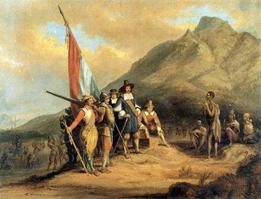
COMMUNIST TAKE OVER OF SOUTH AFRICA AT SOWETO
Before the arrival of the White man, the Bantu children of South Africa were taught farming, fishing, hunting, weaving, etc. by their parents and by tribal teachers. In 1652 Jan van Reibeeck arrived at the Cape of Good Hope to build a fort to signal ships and boats to escort them into the bay.
Christian missionaries arrived in the 1880's to spread Christianity to the cannibals, who welcomed the introduction of furrow irrigation into the drought stricken land. Grass huts were replace with square houses made with European hammers and stone-cutting tools. When the missionaries came, they opened schools to teach reading, writing and math so that the natives could study Christianity from the Bible. The South African government set up schools for their White children, leaving the black children to be taught in the mission schools which were located in the Black reservations. In 1909 the South African government decided to allow the Black children to attend the White schools, with designated areas for Blacks.
In 1909 the government decided to stop funding the mission schools and the Black children were allowed to attend the white schools. The mission schools closed down. The government hired tribal teachers to teach the Black children their ancient tribal skills in their indigenous Bantu and Khoisan languages. The classical European classes in math, science, reading and writing were conducted in Afrikaans and English. This law was codified in the Bantu Education Act of 1953. As time went on English became more popular with the Bantus because it was becoming prominent as the international language of business and science and because it did not carry with it the memory of Apartheid. The Black teachers were teaching more classes in Bantu and English. In order to stop this trend away from Afrikaans the government passed the Afrikaans Medium Decree of 1974 which mandated Afrikaans as one of the official languages of the Bantu Board of Education. This gave the Communists an opportunity to wreak havoc in South Africa which ultimately resulted in the ousting of the South African whites and the whole scale murder of the Whites, the theft of their farms, and the utter destruction of the government, educational system and medical system that had been built by the Whites.
Under Apartheid, the indigenous Africans supported their families with jobs, had access to modern hospitals, and had access to education which prepared their children for better jobs in the future. All this changed when the Communists organized the take-over that resulted in more hunger, less education and a complete dismantling of the medical system.
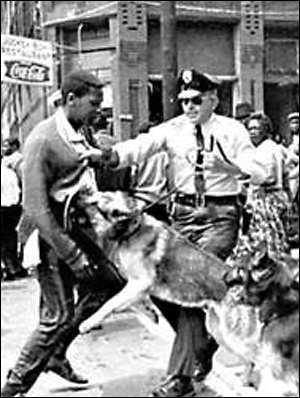 The
Communists created the Civil Rights Movement in the United States and were able
to take over without a shot being fired by teaching Negros nonviolent ways of
changing the society, like sit-ins. When the cops used their dogs to
disperse crowds the American Negros did not fight back. In South Africa,
by contrast, the rioters poured gasoline on the dogs and beat them to death.
The
Communists created the Civil Rights Movement in the United States and were able
to take over without a shot being fired by teaching Negros nonviolent ways of
changing the society, like sit-ins. When the cops used their dogs to
disperse crowds the American Negros did not fight back. In South Africa,
by contrast, the rioters poured gasoline on the dogs and beat them to death.
In South Africa the Communists (African National Congress) incited the Negros to use sabotage, guerrilla warfare, terrorism and open revolution.
David Grewcock photojournalist went to the Soweto riot, wearing the uniform of the Communist: black turtle neck with blazer, long hair and a mustache. The South African police beat him with their batons for using his privilege as a photo journalist to agitate the Negros to riot in the Soweto Uprising in which more than 176 people died, at least 134 of them under the age of 18, suddenly engaging in atrocities, arson, theft, robbery and murder, probably in a drunken state, possibly even drugged, with intoxicants furnished by the Communists to urge children on and suppress their fears.
June 16, 1976 students met at eight secondary schools, with school populations about 500 students each. 10,000 marchers met at the Orlando Stadium from where they started their march.
In the driveway of the hated Bantu Administration Board, youths leapt back as the car they had just overturned went up in a ball of flame. It belonged to a sociologist, Dr Melville Edelstein, who was one of two white officials beaten to death that day. (It says volumes that the toll among the schoolchildren remains imprecise. Estimates range from several dozen deaths on the first day of the uprising to as many as 600.) As we returned, narrowly avoiding a mid-air collision just before landing, the photographer was already developing his film, but none of his pictures could match the impact of the one of Hector Pieterson.
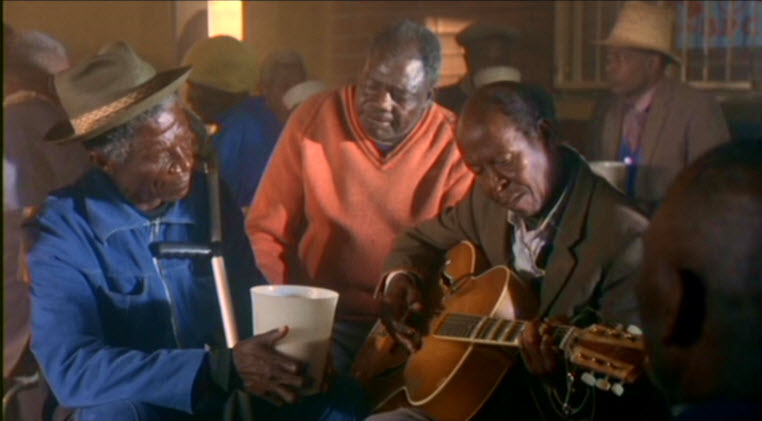
Descriptions of the Soweto riots become more and more ludicrous as time goes by. The original journalistic photographs show a rioting mob killing innocent civilians in spite of gas canisters and dogs being used to herd them away from the village square.
The movie "White Hot Season" depicts the mob as a Ghandiesque peaceful demostration at which the evil White police shoot for no reason at all. The truth is that the mob was armed with machetes, guns, spears and bottles of gasoline which they used to burn buildings, dogs and people.
Movies produced later show the children resisting peacefully, with restrained anger. Later movies show the children angelically singing which causes the evil police to throw tear gas canisters into their sweet faces.
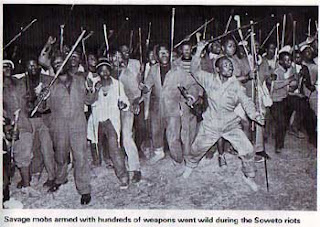
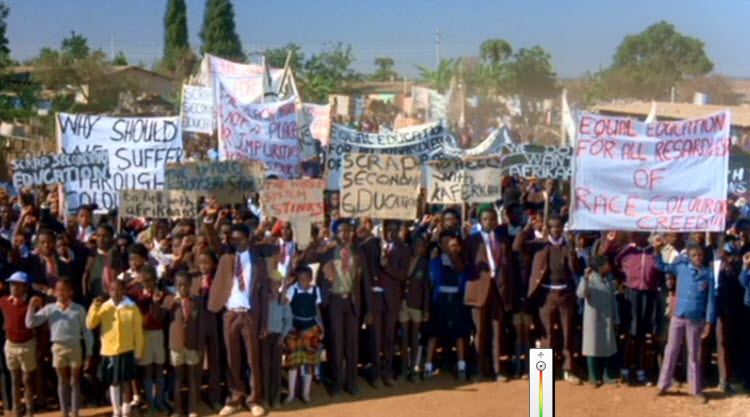
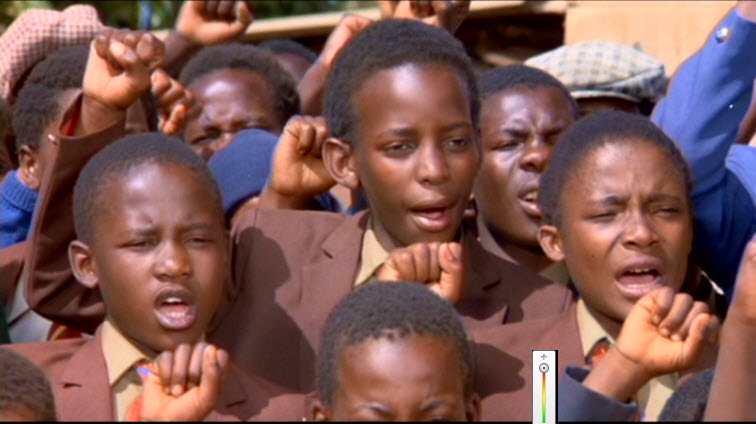
On the day of the riot, students from Naladi High School walked to Batswana Junior Secondary School, and from there they walked to Thomas Mofolo High School. At each school the band added about 500 students to their numbers. The ultimate destination for the march was Orlando Stadium which had a capacity of 24,000. The school children tore apart the half built school and threw missiles made from building materials at the police.
In the center of the small town, police had positioned themselves to protect the storekeepers and the stores. There were police officers on the roofs, protecting the officers in the street who ordered the Whites to seek cover. Tanks were parked on side streets ready to act if violence broke out. The police ordered the 2,000 Negros out of the town square. When the Negros refused to stop their march into the intersection, the police tossed cannisters of tear gas at the advancing mob and set loose German Shepherds who were trained to herd mobs of people out of the area of conflict. Instead of allowing themselves to be herded out of the area of conflict the mob grabbed the dog, poured gasoline on him and set fire to him and beat him to death.
Dr. Edelstein watched this inhumane malfunction and realized that the mob was dangerous. He left his office and went to the parking lot. He got into his car and drove toward the intersection by habit and immediately realized his mistake and attempted to make a U-turn.
The mob recognized him as the social worker who had managed hundreds of their welfare files. They incorrectly assumed he had alerted the police to their mass demonstration because he was trusted by his clients. They grabbed Dr. Edelstein from his car and turned the car over so that they could not be seen. A brave policeman put himself in danger to see what was happening and was shot by one of the mob. The mob poured gasoline on the doctor and set him on fire while they beat him to death with stones. The murderers left a sign around Dr. Edelstein's neck proclaiming "Beware Afrikaaners." The cops on the roof saw everything and alerted the cops on the ground to what had happened. Thus the protest became a battle.
Mobs armed with hundreds of weapons went wild during the Soweto riots. The number of wounded was estimated to be over a thousand men, women and children. Dr. Melville Edelstein was murdered during the Soweto riots by those he south to help. Note the red arrow pointing to the wooden case marked "Beware" thown alongside his body.
Police attempts to calm the crowd verbally, or to disperse the students using dogs and tear gas had no effect. One of the police dogs was caught, set alight and beaten to death. When police saw they were surrounded by the students, they fired shots into the crowd, and pandemonium broke out.
The police loosed their dogs on the children who stone the dogs to death. Then the police shot some of the children. Dr. Melvill Edelstein showed his solidarity with the Blacks. He was the chief welfare officer for the West Rand Bantu Administration. The violence continued until nightfall, Blacks attacking stores, beer halls, administration office and even company delivery vans.
After the incident Henry Kissinger denounced South Africa and the United Nations demanded an end to Apartheid. Movies were made depicting the South African whites as sadistic, using identical imagery as the Jews used to portray Germans as sadistic. The white South African police are depicted as stupid, without discipline. The black policemen are depicted as sexual exploiters of young girls. In fact, photographs of the event show that the police, both black and white, were well trained, courageous and smart. 23 people died in the protest including two White people. These deaths were mostly cause by police who had been surrounded by the mob which was armed and attacking.
The incident was created by the Communists to force the police to defend themselves after which the incident was falsely reported and used to show the police as so brutal that there had to be a regime change.
In the movie "Sarafina" the brutal killing of Dr. Edelstein is depicted as the justified revenge for Edelstein's habitual betrayal of the Black people he spent his life educating and uplifting. The character in the movie is named "Constable Sebelia."